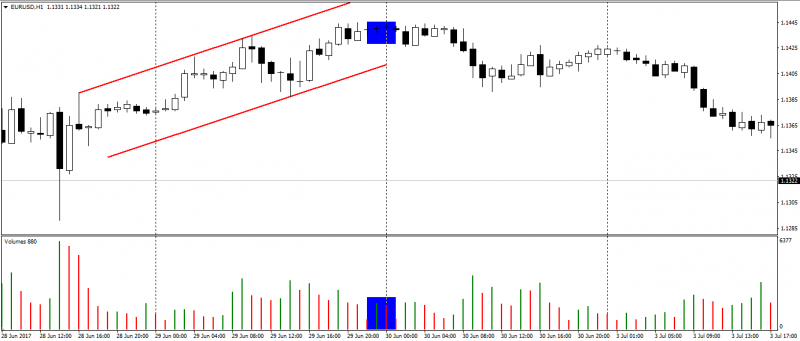
VSA аналіз – коротко про головне! Антон Ганзенко.
VSA (Volume Spread Analysis) – метод аналізу торгового обсягу в поєднанні з розмірами свічки і їх загального стану. VSA аналіз – це досить об’ємний курс, який ґрунтується на технічному аналізі ринку і вказує на поведінку великих грошей. Звичайно, всі нюанси і тонкощі VSA аналізу помістити в одну статтю неможливо, але описати основні принципи і поняття цілком можливо.
Детально розшифрувавши абревіатуру VSA (Volume Spread Analysis), розуміємо, що сам аналіз спирається на обсяг і спред, у цьому випадку спред – це не різниця між ціною покупки і продажу, а різниця між точками відкриття і закриття свічки або її максимумом і мінімумом.
Що дає аналіз VSA?
- Визначає закінчення тренду
Аналіз VSA дозволяє за допомогою мінімальних наборів індикаторів визначити можливі точки закінчення або розвороту тренду. Сигнал до закінчення по аналізу – це відносно низький обсяг торгів при невеликому спреді свічки після деякого тренду.
Так, у нас є якийсь тренд, який рухається в коридорі в сторону основного руху і корекції.

На малюнку наведено приклад висхідного тренду, де зони росту і корекції відповідають обсягу торгів. Сигналом до його закінчення служить виникнення свічки з маленьким спредом і досить значним обсягом. Це, як правило, вказує на закінчення або розворот тренду. Адже основні обсяги торгів, які штовхали ціни, вийшли з ринку або змінили напрямок.
- Визначення сили й напрямку тренду
При визначенні сили тренду потрібно відразу визначитися з такими поняттями:
- Бичачий обсяг – зростання обсягу на свічках, що зростають і зниження на свічках, що знижуються.
- Ведмежий обсяг – зростання обсягу на свічках, що знижуються і зниження на свічках, що зростають.
Виходячи з даних визначень випливає:
- для бичачого обсягу – висхідний ринок визначається на ведмежих свічках. Це означає, що великі гравці на свічках, що зростають, купують, а на свічках, що знижуються, не продають.
- для ведмежого обсягу – спадний ринок визначається на бичачих свічках. Це означає, що великі гравці на свічках, що зростають, не купують, а на свічках, що знижуються, продають.
На перший погляд інформація здається заплутаною і незрозумілою, але після нетривалої практики все стає зрозумілим.
Недолік VSA аналізу
Основним недоліком є відсутність чітких умов до дії, оскільки аналіз ґрунтується на відносному обсязі торгів, тому кожна конкретна ситуація вимагає індивідуального підходу враховуючи попередню динаміку ринку.
Незважаючи на значний недолік, VSA аналіз може стати відмінним доповненням до будь-якої торговельної стратегії або лягти в основу прибуткової стратегії для заробітку.
Якщо Вам цікаво дізнатися більше з цієї теми – відповідайте на питання нижче і стежте за Блогом Трейдера!
Антон Ганзенко